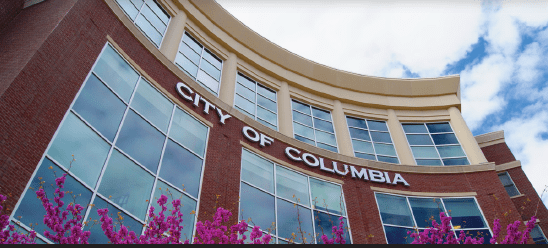Utility Tree Trimming
Is there a tree on your property with branches near an electric line that you want trimmed or removed? Please fill out our online Tree Trimming Request Form.
- Why does Columbia Water & Light trim trees?
Properties with trees growing into power lines are likely to experience ‘blinks’ in electric service or power outages. Columbia Water & Light budgets $2 million annually to trim trees along overhead power lines. Regularly scheduled tree trimming helps the reliability of the electric system and keeps the amount needing to be trimmed to a minimum. - How will I be notified when trees on my property need to be trimmed?
Columbia Water & Light will notify property owners two to three weeks before trees are to be trimmed. You can agree to either having your tree(s) trimmed or removed. If a tree damages electric infrastructure, the tree(s) will be cut back so service can be restored. - Will all the tree debris be removed?
During routine tree trimming, Columbia Water & Light tree trimming contractors will take away the smaller branches that were removed. When a tree is removed, larger limbs will be cut in 16-inch to 20-inch sections and left at the site to be used as firewood. Tree stumps are not removed. If tree trimming is done by the utility because of storm damage, the tree debris will not be removed. - How does Columbia Water & Light decide how much to trim?
Columbia Water & Light’s policy is to trim trees enough so the branches will not interfere with the electric lines before the next trimming cycle. Trees along transmission lines and large distribution lines are trimmed on a one- to two-year cycle. The amount of the tree that is trimmed depends on how much a particular species will grow before the next trimming cycle. Proper trimming practices prescribed by the National Arbor Day foundation are followed to maintain the health of the tree. - How can I avoid electrical problems because of trees?
When planting trees, it’s important to choose the site based on what the tree will look like when it is fully grown. Make sure that there is plenty of room for the tree to grow above and below the ground. Plant trees away from overhead power lines (see image below), driveways and sidewalks. Remember there are also utilities like sewer, water and electric lines underground. Planting too close to your utility lines can eventually cause problems with your services.
Always call before you dig, it’s the law. 1-800-DIG-RITE (Missouri One Call). Remember, locators only mark utility owned infrastructure, not the connection from the water meter or sewer connections to your home.
Large (> 70 feet): Medium (30 to 70 feet):
Small (< 30 feet):
Shrubs (to 15 feet): Shagbark Hickory Marshall Seedless Flowering Dogwood Euonymus Manhattan Black Walnut Littleleaf Linden Eastern Red Cedar Beautybush
Austrian Pine Norway Maple Russian Olive Wahoo Basswood Sugar Maple Crabapple Burning Bush Bur Oak or Pin Oak Kentucky Coffeetree Hawthorn Lilac White Pine English Oak Redbud Rose-of-Sharon Pecan Pagoda Tree Forsythia Scotch Pine Ash Mockorange Sweetgum Pyracanthia - Problematic trees to avoid
The following trees are susceptible to broken limbs, disease and other problems in our area:
Box Elder
Cottonwood and Hybrid Poplar
Lombardy Poplar
Osage Orange
Siberian (Chinese) Elm
Silver Poplar
Silver Maple
Sycamore
Weeping Willow
Tree of Heaven (Ailanthus)
CAUTION:
Always call 1-800-DIG-RITE (Missouri One Call) to have the location of all utilities marked before doing any digging in your yard. Sewer and water lines will only be marked on the city side of the meter. Lines running from the meter to a home are not located by the utility.
Columbia Ordinance for this program: Chapter 27, Section 27-165

